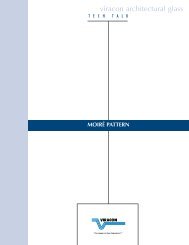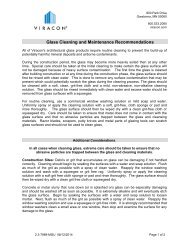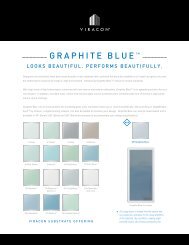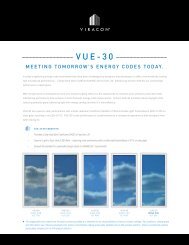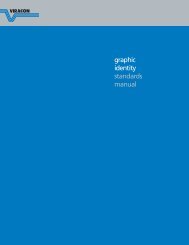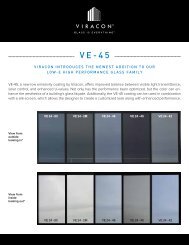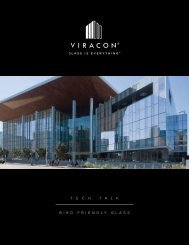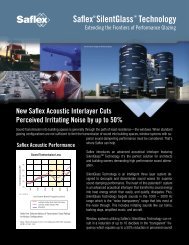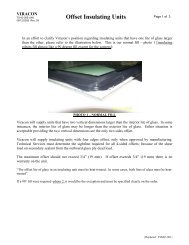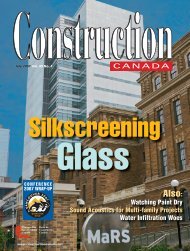Product Specification Guide - Viracon
Product Specification Guide - Viracon
Product Specification Guide - Viracon
Create successful ePaper yourself
Turn your PDF publications into a flip-book with our unique Google optimized e-Paper software.
protective<br />
glass<br />
specs & tech<br />
hurricane-resistant<br />
blast mitigating<br />
safety & security defense
2<br />
protecting people, property and peace of mind<br />
from natural disasters and man made threats<br />
It all starts with taking your “what if”<br />
questions and turning them into “why<br />
not” answers. Chances are, we’ve recom-<br />
mended a protective glazing solution<br />
for a similar specialty glass job over the<br />
years. And chances are today, we can<br />
give you a point of view other fabrica-<br />
tors just don’t feel comfortable talking<br />
about. Trust, confidence, peace of mind<br />
— it’s what protective glass experience,<br />
a broad selection of glazing options<br />
and the technical expertise to fabricate<br />
customized solutions can do for you.<br />
<strong>Viracon</strong> offers you more than just pure<br />
protective glazing options.<br />
You’ll also find a wide selection of pro -<br />
tective glass designed to offer acoustical,<br />
thermal and aesthetic performance<br />
through our complete product offering,<br />
including: insulating, laminated, silk-<br />
screened, spandrel, heat-treated and<br />
high-performance coated glass. After all,<br />
the last thing we want is for you to have<br />
to make design changes that compromise<br />
your vision. And your clients’. It’s simple:<br />
when it comes to working with you on<br />
protective glazing, we’re high-impact<br />
problem solvers. Challenge us, you’ll see.<br />
<strong>Viracon</strong> Protective Glass incorporates a laminated<br />
component capable of resisting threats from hurri canes,<br />
tornadoes, seismic events, mitigate against the effects<br />
of bomb blasts and/or forced entry threats.<br />
Jade Ocean<br />
Sunny Isles Beach,<br />
Florida<br />
Architect: Carlos A.<br />
Ott & Associates<br />
Glazing Contractor:<br />
Permasteelisa CS,<br />
Continental Glass<br />
Systems<br />
Photographer: Fred<br />
Gerlich Photography
viraconsulting <br />
get our thinking on your thinking<br />
Architects and contractors turn to us to help them solve their<br />
toughest challenges when it comes to specifying protective glass for<br />
a variety of applications. You can count on our <strong>Viracon</strong>sulting <br />
services to provide the perfect set of resources to build on your ideas.<br />
Field Sales Representatives<br />
We’re here to help with design assistance,<br />
budget costing, return on investment<br />
costing, specification writing and<br />
review as well as act as a liaison<br />
between architects and glazing con-<br />
tractors. We also work closely with<br />
the glazing contractor to offer assis-<br />
tance with initial costs, final pricing<br />
negotiations, product information and<br />
job site inspections. Just ask.<br />
Techelp<br />
Need an answer - fast? Our<br />
Architectural Technical Services<br />
group, along with our Architectural<br />
Design group, can assist you with<br />
specification and design solutions,<br />
performance and environmental analy-<br />
sis, structural calculations and energy<br />
payback for hurricane-resistance, and<br />
security threat requirements.<br />
Account Representatives &<br />
Customer Support<br />
Call us to help with quoting, product<br />
performance data, pricing, project<br />
coordination, samples and mockups.<br />
3
4<br />
<strong>Viracon</strong> hurricane-resistant glass options<br />
extreme protection for extreme conditions<br />
PVB Laminated Glass<br />
Glass<br />
Polyvinyl<br />
Butyral<br />
<strong>Viracon</strong> PVB laminates, consisting of a<br />
standard architectural polyvinyl butyral<br />
interlayer laminated between two panes<br />
of glass, have proven suitable for varying<br />
degrees of hurricane protection.<br />
• .060" pvb thickness has qualified for small<br />
missile impact requirements<br />
• .090" pvb thickness has qualified for large<br />
missile impact requirements –performance<br />
is generally limited to lower design<br />
pressures and smaller glass sizes<br />
†Building code requirements vary by geographic region.<br />
Contact the building code officials of the project<br />
location for the applicable standard.<br />
Statements regarding product performance are based<br />
on historical test results.<br />
SentryGlas ®<br />
There’s no ifs, ands or buts about it, <strong>Viracon</strong>’s line<br />
of Hurricane-Resistant Glass (HRG) gives you the<br />
best chance to stand up to Mother Nature’s fury.<br />
All our HRG products meet or exceed stringent<br />
code requirements of Florida and other coastal<br />
regions.† And every product has passed the impact<br />
and cyclic wind pressure tests as part of a complete<br />
glazing system.<br />
Glass<br />
SentryGlas<br />
<strong>Viracon</strong> SentryGlas ® laminate incorporates<br />
the DuPont SentryGlas ionoplast interlayer<br />
bonded directly between two layers of glass<br />
for superior protection.<br />
• Rigid interlayer minimizes deflection<br />
• Available interlayer thicknesses:<br />
.060", .090", .100"<br />
• The .090" and .100" SentryGlas interlayers<br />
are typically used in large missile applications<br />
• Maximum producible size*: 72" x 120"<br />
(1829mm x 3049mm) – Lengths to 144"<br />
(3658mm) are subject to availability<br />
StormGuard <br />
Glass<br />
Saflex HP<br />
<strong>Viracon</strong> StormGuardTM is composed of an<br />
enhanced polyvinyl butyral (PVB) interlayer<br />
which provides excellent adhesion to glass<br />
and optimum performance for large missile<br />
applications.<br />
• Less deflection and better tear resistance<br />
than standard PVB interlayers<br />
• Available with colored interlayers, i.e.:<br />
Vanceva ® Arctic Snow<br />
• Maximum producible size*: 72"x 144"<br />
(1829mm x 3658mm)
Park Place at Brickell II<br />
(1450 Brickell)<br />
Miami, Florida<br />
Architect: Nichols, Brosch, Wurst, Wolfe and<br />
Associates<br />
Glazing Contractor: Enclos Corp.<br />
Photographer: ©Jorge Molina/Emporis<br />
Vanceva ® Storm<br />
Glass<br />
PVB/PET<br />
Film/PVB<br />
Composite<br />
<strong>Viracon</strong> Vanceva ® Storm laminate consists<br />
of a Saflex ® PVB / PET film / PVB composite<br />
laminated between two panes of glass.<br />
The composition provides the impact resistance<br />
of polyvinyl butryal and the tear<br />
resistance of polyethylene terephthalate<br />
(PET) film, providing you with the ultimate<br />
in hurricane protection.<br />
• Less deflection than standard pvb<br />
• Tear resistance of PET film<br />
• Maximum producible size*: 60" x 144"<br />
(1524mm x 3658mm)<br />
For larger sizes, contact us for further<br />
information.<br />
ViraStorm-E<br />
Glass<br />
Level E<br />
Composite<br />
<strong>Viracon</strong> ViraStorm-E laminated glass was<br />
designed for the requirements of ASTM E<br />
1996-04 Missile Level E for essential facilities.<br />
The laminate is comprised of an enhanced<br />
interlayer composition, offering a higher<br />
level of performance compared to thinner<br />
interlayer constructions.<br />
• Composite thickness is .177"<br />
• Maximum producible size*: 60" x 144"<br />
(1524mm x 3658mm)<br />
For larger sizes, contact us for further<br />
information.<br />
*Maximum producible size does not imply that the<br />
product will pass hurricane testing at the stated size.<br />
The minimum size for the heat treated laminated<br />
glass is 12” x 36” (305mm x 914mm).<br />
Did you know?<br />
<strong>Viracon</strong> protective glass laminates provide several other<br />
benefits in addition to storm protection:<br />
• Acoustical performance – Laminated glass reduces<br />
noise transmission due to the sound damping<br />
characteristics of the interlayer<br />
• Safety – Laminated glass meets national safety<br />
standard ANSI Z97.1 and the Federal Safety Standard<br />
CPSC 16 CFR 1201<br />
• Ultraviolet/Solar protection – Provides 99% UV light<br />
blockage at the wavelength range of ~300 - 380<br />
nanometers<br />
• The abrasion-resistance surface of glass<br />
• Thermal performance and pleasing aesthetics, when<br />
incorporated with <strong>Viracon</strong> high-performance coatings<br />
(see page 11), in insulating units, with silk-screen<br />
patterns, etc.<br />
Depending upon your climate, if you upgrade a clear<br />
glass laminate to an insulating unit with a laminated<br />
inboard ply, and incorporate a VE-2M coating on the<br />
#2 surface, you can optimize the thermal performance<br />
by approximately 50% and earn a cost payback within<br />
four years!<br />
When choosing the right hurricane-resistant<br />
glass for your application, the following<br />
points must be evaluated:<br />
• Determine the applicable building code and test<br />
method †<br />
• Determine the required design pressure/wind load<br />
• Qualify the missile requirement – large and/or<br />
small missile<br />
• Identify the largest glass size<br />
• If using a tested or certified framing system, confirm<br />
the laminated glass qualified with the particular<br />
manufacturer’s product<br />
• If not using a tested or certified frame, evaluate<br />
system design details, such as:<br />
— Glazing method: conventional or structurally glazed<br />
— Glass bite – Often large missile applications<br />
require a minimum edge engagement of 5/8” to<br />
augment performance<br />
• Anchorage and hardware requirements – Typically<br />
large missile applications require an enhanced design<br />
Turtle Code<br />
The Florida Marine Turtle<br />
Protection law requires architectural<br />
glass to transmit no more than<br />
45% of light from inside. Contact us to determine<br />
performance data compliance.<br />
5
6<br />
<strong>Viracon</strong> blast mitigating glass<br />
keeps it all together<br />
Laminated glass offers protection when a building is exposed to the threat of explosives. Tests have shown<br />
that when windows glazed with laminated glass are subjected to a blast impulse, broken glass fragments<br />
tend to adhere to the plastic interlayer rather than spraying building occupants with harmful glass shards or<br />
other debris.<br />
At <strong>Viracon</strong>, we provide laminated glass solutions that help mitigate the effects of explosive events. Many<br />
critical factors must be considered when designing the glazing and at <strong>Viracon</strong> we’re here to help you every<br />
step of the way. The fact is, when installed into a glazing system, <strong>Viracon</strong> laminates can be designed to meet<br />
the requirements of the Department of State, Department of Defense, General Services Administration (GSA)<br />
and other government or industry standards.<br />
Laminated glass is considered a component of the overall system. Therefore, the blast mitigating performance<br />
is also dependent upon being installed into an adequately designed frame. <strong>Viracon</strong> recommends the involve-<br />
ment of a blast consultant to verify the performance of the glass and glazing system combination.<br />
US Federal Courthouse<br />
Minneapolis, Minnesota<br />
Architect: Kohn Pedersen Fox Associates<br />
Glazing Contractor: Flour City Architectural Metals<br />
Photographer: Jerry Swanson Photography<br />
Alfred A. Arraj United States<br />
Federal Courthouse<br />
Denver, Colorado<br />
Architect: Anderson Mason Dale Architects<br />
in association with<br />
Hellmuth, Obata + Kassabaum<br />
Glazing Contractor: A-1 Glass<br />
Photographer: Frank Ooms Photography<br />
Many factors must be considered<br />
when evaluating which laminated glass<br />
product is suitable for a specific blast<br />
mitigating application:<br />
• Blast Load including the Pressure (psi),<br />
Duration (msec) and Impulse<br />
(psi*msec) OR the TNT load equivalent<br />
and Standoff Distance<br />
• ISC/GSA or ASTM F1642 Injury Hazard<br />
Classification Levels<br />
• Glass Size<br />
• Framing Design including Anchorage,<br />
Glass Bite, Hardware, etc.
Glass<br />
Low to Medium Performance<br />
Blast Mitigating Laminates for low to<br />
medium performance could include:<br />
• PVB Laminated Glass: .030", .060",<br />
.090" interlayer thicknesses<br />
Polyvinyl Butyral<br />
• Insulating Laminates (with laminate to<br />
interior/protected side)<br />
(Performance dependent upon<br />
factors as stated on page 6)<br />
Tests prove that when windows glazed with laminated glass are subjected to a blast impulse, broken<br />
glass fragments tend to adhere to the plastic interlayer rather than spraying building occupants.<br />
Medium to High Performance<br />
Blast Mitigating Laminates for medium to<br />
high performance could include:<br />
• Double Laminated Insulating Glass<br />
(two laminates separated by air spacer)<br />
• Enhanced Interlayer Laminates, i.e.:<br />
StormGuard, SentryGlas, Vanceva Storm<br />
• Multi-ply Laminates<br />
• Glass-Clad Polycarbonates<br />
• Custom Glazing Configurations<br />
(Performance dependent upon factors as<br />
stated on page 6)<br />
<strong>Viracon</strong>sulting<br />
<strong>Viracon</strong>’s expertise and proven<br />
performance is visible on proj-<br />
ects throughout the world. We<br />
can assist in offering custom<br />
glazing options for specific<br />
threat levels and performance<br />
requirements. Contact our<br />
Technical Service Department<br />
at 800-533-2080 for assistance.<br />
7
8<br />
<strong>Viracon</strong> safety & security<br />
ballistic and forced-entry glass<br />
Insur-Lite<br />
Insur-Lite uses two pieces of annealed glass bonded<br />
together by an .060” (1.52mm) PVB interlayer, offering<br />
low level security at a reasonable cost. It’s an excel-<br />
lent choice for computer rooms, financial institutions,<br />
jewelry stores and other areas where the possibility of<br />
break-in’s exist. For added resistance to breakage,<br />
<strong>Viracon</strong> recommends heat strengthening the glass plies.<br />
<strong>Product</strong> Notes: Maximum size of 80” x 144” (2032mm x 3658mm) up<br />
to 50 square feet (1.97 sq.meters) for annealed laminates Insur-lite<br />
516 and 916 feature U.L. 972 listing for burglar-resistant glazing.<br />
<strong>Product</strong> Code<br />
Insur-Lite 516<br />
Insur-Lite 716<br />
Insur-Lite 916<br />
Insur-Lite Laminated Glass <strong>Product</strong>s<br />
Average Thickness<br />
.31"<br />
.43"<br />
.51"<br />
Average Weight<br />
3.6 lbs/ft 2<br />
5.2 lbs/ft 2<br />
6.2 lbs/ft 2<br />
Glass-Clad Polycarbonates<br />
<strong>Viracon</strong> offers glass-clad polycarbonates<br />
(GCP) for protection against ballistic and<br />
prolonged physical attack threats. These<br />
laminates are supplied for exterior glazing of<br />
commercial and government buildings where<br />
severe threats are high. The products offer<br />
superior performance over the capabilities of<br />
standard PVB or conventional laminates,<br />
which can protect against “smash and grab”<br />
threats and provide lower threat perform-<br />
ance. Glass-clad polycarbonates are often used in<br />
conjunction with other <strong>Viracon</strong> design features to<br />
achieve thermal and aesthetic benefits.<br />
<strong>Viracon</strong> glass-clad polycarbonates carry test certifications for<br />
specific threat levels per Underwriters Laboratory (UL), H.P. White<br />
and WMFL standards. They can also be constructed to qualify for<br />
additional standards, such as NIJ, Department of State (DOS) and<br />
others. Keep in mind that you may be able to achieve multiple<br />
threat protection with a single glazing product! <strong>Viracon</strong> will work<br />
with you to determine the appropriate product for specific threat<br />
levels to meet your safety and security performance needs.<br />
Glass-Clad Polycarbonates<br />
GCP laminates are composed of<br />
a polycarbonate core laminated<br />
between two panes of glass. For<br />
no-spall criteria, a SpallshieldTM Glass<br />
Polyurethane<br />
Polycarbonate<br />
film is<br />
laminated to the inner most surface.<br />
Checklist:<br />
• Identify the protection criteria needed, i.e. ballistic, forced-entry, blast, etc.<br />
• Determine the test standard and/or threat level required<br />
• If multiple threat protection is required, determine the priority<br />
• Confirm the thermal and aesthetic values desired<br />
As with all protective glazing, the framing system plays a vital role<br />
in the performance and must be adequately designed.
GuardVue ®<br />
The GuardVue ® line of ballistic products are constructed with one or more glass plies toward the “attack”<br />
side and a Spallshield laminate toward the “witness” side. This combination uses glass to flatten and slow<br />
the bullet while relying on the flexible polycarbonate to absorb the force of the impact. Combined, GuardVue<br />
ballistic products offer you an effective barrier against high-powered firearms, both handguns and rifles.<br />
<strong>Viracon</strong> offers the following ballistic products which are U.L.752 listed.<br />
GuardVue ® 3000<br />
U.L. 752 Listed Level 3<br />
Bullet & Physical Attack Resistant<br />
Glass-Clad Polycarbonate<br />
Clear Glass<br />
Polycarbonate<br />
Composite<br />
PVB Interlayer<br />
Spallshield<br />
<strong>Viracon</strong> GuardVue 3000 can also<br />
be configured into insulating glass<br />
units to improve solar control, thermal<br />
performance and harmonize<br />
with adjacent architectural glass.<br />
• Average Thickness: 1.27”<br />
• Maximum Size: 60” x 96”<br />
• Average Weight: 10.9 lbs/ft 2<br />
• U.L. 752 Listed Level 3 –<br />
.44 Magnum<br />
• H.P. White TP-0500.02 – Level III<br />
(Step 25) – Forced Entry<br />
• WMFL Level 1 – .44 Magnum<br />
and 60-Minute Physical Attack<br />
• Five Years from Date of<br />
Manufacture for Laminated<br />
For additional information regarding <strong>Viracon</strong>’s safety & security glazing, reference the Protective Glass products section<br />
of our web site at www.viracon.com.<br />
GuardVue ® 4200<br />
U.L. 752 Listed Level 4<br />
Bullet & Physical Attack Resistant<br />
Insulating Glass System<br />
Clear Glass<br />
PVB Interlayer<br />
Polycarbonate<br />
Composite<br />
Spallshield<br />
Airspace<br />
<strong>Viracon</strong> GuardVue 4200 is a stan-<br />
dard insulating glass unit consisting<br />
of an all-glass laminate, sealed airspace<br />
and glass-clad polycarbonate<br />
with Spallshield.<br />
• Average Thickness: 2.28”<br />
• Maximum Size: 48” x 60”<br />
• Average Weight: 19.0 lbs/ft 2<br />
• U.L. 752 Listed Level 4 –<br />
.30 Caliber Rifle<br />
• H.P. White TP-0500.01 –<br />
Level I – Forced Entry<br />
• Five Years from Date of<br />
Manufacture for Laminated<br />
• Ten Years from Date of<br />
Manufacture for Insulating Seal<br />
GuardVue ® 8200<br />
U.L. 752 Listed Level 8<br />
Bullet & Physical Attack Resistant<br />
Insulating Glass System<br />
Clear Glass<br />
PVB Interlayer<br />
Polycarbonate<br />
Composite<br />
Spallshield<br />
Airspace<br />
<strong>Viracon</strong> GuardVue 8200 is a stan-<br />
dard insulating glass unit consisting<br />
of an all-glass laminate, sealed airspace<br />
and glass-clad polycarbonate<br />
with Spallshield.<br />
• Average Thickness: 2.92”<br />
• Maximum Size: 48” x 60”<br />
• Average Weight: 27.4 lbs/ft 2<br />
• U.L. 752 Listed Level 8 –<br />
7.62 NATO<br />
• Five Years from Date of<br />
Manufacture for Laminated<br />
• Ten Years from Date of<br />
Manufacture for Insulating Seal<br />
9
10<br />
specs & tech<br />
what you need to know<br />
Glazing <strong>Guide</strong>lines<br />
<strong>Viracon</strong> requires that only 100% silicone setting blocks be used for all<br />
types of glazing systems. The blocks should have a durometer hardness<br />
of 85±5. They should also be centered<br />
85 ± 5 Shore A Durometer Blocks<br />
centered at 1/4 points with length<br />
at quarter points and be 1/16" (1.6mm)<br />
less than the channel width (see Figure1).<br />
dependent upon glass area.<br />
Weep System<br />
(3/8" Diameter<br />
For glass-clad polycarbonate laminates,<br />
ensure that the setting blocks are<br />
Holes)<br />
manufactured of santoprene, silicone,<br />
EPDM or any polycarbonate compatible<br />
material. Avoid neoprene, since it can<br />
W/4<br />
Figure 1<br />
W/4<br />
be incompatible with polycarbonates.<br />
Adequate clearances must be maintained<br />
to prevent glass damage or breakage as a result of glass-to-frame contact.<br />
Provide uniform face clearance by installing<br />
a cushioning material between the<br />
framework and the glass components.<br />
<strong>Viracon</strong> recommends a minimum face<br />
clearance of 1/8" (3mm) and a minimum<br />
Face<br />
edge clearance of 1/4" (6mm) (see Figure 2). Bite<br />
Edge Engagement<br />
Edge<br />
Normally the edge engagement or bite of<br />
a protective glass laminate is required to be<br />
Figure 2<br />
deeper than traditional applications not intended to mitigate against<br />
man-made threats or threats of nature. This requirement is to augment<br />
performance of the glazing and framing system. For hurricane and blast<br />
applications, the required edge engagement is dependent upon such<br />
factors as the design load, the glazing system and the glass product.<br />
For ballistic and forced-entry application, most test standards specify<br />
a 1" (25mm) edge engagement. Engagements less than 1" can be used;<br />
however, test certifications may no longer be applicable.<br />
Avoid excessive edge clamping pressure since it can result in glass breakage<br />
or premature delamination.<br />
Weep Systems<br />
Closed-Cell<br />
Neoprene<br />
Do not expose the edges of lam inated or Gasket<br />
insulating lami nated glass to standing<br />
water. This can cause premature seal failure<br />
or delamination. <strong>Viracon</strong> requires either<br />
imper vious weather seals or an adequate<br />
weep system to prevent this from<br />
Weep<br />
occurring (see Figure 3). This is also true<br />
Figure 3<br />
of lockstrip gasket glazing. The glazing<br />
system manufacturer or designer is ultimately responsible<br />
for the design of the weep system and its proper performance.<br />
Dense<br />
Wedge<br />
Gasket<br />
Glass Handling and Storage<br />
Care needs to be taken during handling and glazing to ensure that glass<br />
damage does not occur. Do not allow glass edges to contact the frame or<br />
any hard surfaces during installation. Use rolling blocks if the laminated<br />
units are rotated or “cartwheeled” on their corners. Damaged glass<br />
edges can ultimately result in delayed glass breakage as the units<br />
encounter in-service thermal and mechanical stresses. <strong>Viracon</strong> assumes<br />
no responsibility for glass breakage.<br />
Improper glass storage techniques may result in glass breakage or damage<br />
to glass components, glass surfaces, or coatings. Store glass crates<br />
properly to prevent them from tipping. In addition, store glass indoors<br />
whenever possible. Do not subject the glass to rain, water or direct<br />
sunlight. In order to prevent condensation and subsequent glass staining<br />
while in storage, the temperature of the stored glass must remain above<br />
the dew point temperature of the air. If outdoor storage is unavoidable,<br />
construct a protective canopy using a waterproof, light blocking material<br />
that allows air circulation around the tops and sides of the cases. Ensure<br />
that stored glass and interleaving material are kept dry.<br />
Maintenance and Cleaning<br />
Once the glass is installed, the glazing contractor should make provisions<br />
to ensure that the glass surfaces are protected from possible damage<br />
caused by the construction practices of other trades. For routine cleaning,<br />
use a mild soap detergent and lukewarm water. Uniformly spray the<br />
cleaning solution or apply it with a clean, soft, grit-free applicator and<br />
rinse thoroughly. Dry the glass surface with a clean, grit-free cloth or a<br />
squeegee. Do not allow any metal or hard parts of the cleaning<br />
equipment to contact the glass surfaces.<br />
Glass-Clad Polycarbonates<br />
Careful consideration must be made with regard to incompatible<br />
materials that may come in contact with the laminate and polycarbonate<br />
core. Contact of such materials results in cracking of the polycarbonate.<br />
The cracking may appear as a fine crazing at the edge of the laminate or,<br />
in some cases, significant cracks develop that give the appear ance of the<br />
glass itself being cracked. In all occurrences evaluated, incompatible<br />
substances have come in contact with the polycarbonate and caused<br />
the cracking.<br />
In most cases, the potential for exposure to incompatible materials<br />
occurs after installation. A common situation is chemical run-off from the<br />
building exterior or cleaning solutions used on the interior of the building.<br />
For this reason, <strong>Viracon</strong> recommends that a silicone cap bead be<br />
applied around the entire perimeter between the laminate face<br />
and the retention frame on both the interior and exterior glass<br />
surfaces. <strong>Viracon</strong> does not recommend that silicone come in contact<br />
with the edge of the polycarbonate.<br />
Known Incompatible Materials<br />
Do not expose the edges of glass-clad polycarbonates to acids or solvents<br />
which include one or more of the following: Ammonia, Acetone, MEK,<br />
Methylene Chloride, Phenol, Mineral Spirits or Zylene. This is a partial list<br />
of incompatible chemicals for polycarbonates. For questions on other<br />
material, please contact the material supplier or <strong>Viracon</strong>’s Technical<br />
Services group at 800-533-2080.
Spandrel Applications<br />
Typically non-vision building areas are clad with monolithic spandrel glass.<br />
With the enactment of hurricane impact building codes, laminated glass<br />
became a requirement for spandrel glass areas, as well as vision areas.<br />
Because spandrel areas are not typically temperature controlled, elevated<br />
temperatures in these areas require the following guidelines:<br />
1. The laminated make-up incorporates a high performance, solar<br />
controlling coating whose solar reflection is 10% or greater.<br />
2. The make-ups incorporate a white ceramic frit.<br />
3. Or, the space behind the glass be vented to prevent excessive heat<br />
build-up. This requirement applies to all applications of SentryGlas<br />
laminates in spandrel areas.<br />
Coating Offering by <strong>Product</strong><br />
The table below summarizes the <strong>Viracon</strong> coatings available with each type<br />
of laminated glazing. All of <strong>Viracon</strong>’s coatings and substrate tint offerings<br />
are available when the laminate is the inboard ply of an insulating glass unit.<br />
Inspection <strong>Guide</strong>lines<br />
Coated Glass Inspection <strong>Guide</strong>lines. (<strong>Viracon</strong>’s coated glass products<br />
comply with ASTM Standard C 1376.)<br />
• Pinholes – Inspect glass from a distance of 10 ft. (3m) in transmission,<br />
at a viewing angle of 90˚ to the specimen, against a bright uniform<br />
background. If a pinhole is readily apparent, the following criteria apply:<br />
Pinholes larger than 1/16" (1.6mm) in diameter are not allowed in 80<br />
percent of the central glass area. Pinholes larger than 3/32" (2.4mm) are<br />
not allowed in the outer 20 percent of the glass area. No more than two<br />
readily apparent blemishes are allowed in a 3" (75mm) diameter circle<br />
and no more than five readily apparent blemishes are allowed in a 12"<br />
(300mm) diameter circle.<br />
• Uniformity – When viewing coated glass from a minimum distance of<br />
10 ft. (3m), color variation may occur from one unit to another. This can<br />
be caused by variations within the float glass substrate and normal<br />
production variations and this is not considered a defect. All <strong>Viracon</strong><br />
PVB Laminated Glass<br />
SentryGlas ®<br />
StormGuard <br />
Vanceva ® Storm<br />
ViraStorm-E<br />
Contact <strong>Viracon</strong> for the availability of coatings not listed above.<br />
commercial glass products conform to industry color standards.<br />
• Distortion – Various factors involved in heat processing, insulating air<br />
spaces and frame binding may distort reflected objects viewed on the<br />
glass surface. These are not con sidered defects of the coated glass or the<br />
final fabricated product.<br />
<strong>Viracon</strong> Coatings Availability by <strong>Product</strong><br />
• Scratches – Inspect glass from a distance of 10 ft. (3m). Scratches up<br />
to 2" (50mm) are allowed in 80 percent of the central glass area, and<br />
scratches up to 3" (75mm) are allowed in the outer area. Concentrated<br />
scratches or abraded areas are not allowed.<br />
Note: The maximum size for annealed glass under any condition is<br />
50 sq. ft. (4.65 sq. m.) Maximum size for heat-treated glass under<br />
any condition is 65 sq. ft. (6.04 sq. m.), vertical application, and<br />
40 sq. ft. (3.70 sq. m.) for sloped glazing. Maximum piece weight<br />
is 750 pounds (226 kg).<br />
For complete information on all of <strong>Viracon</strong> products including: insulating,<br />
silk-screened, spandrel, laminated, protective, monolithic and acoustical<br />
glass, visit www.viracon.com, or contact us at glass@viracon.com or by<br />
calling 800-533-2080.<br />
Continuing Education<br />
We also work with professional organizations and firms<br />
worldwide to provide AIA registered educational<br />
seminars. As a registered provider with the<br />
AIA/Continuing Education System (AIA/CES),<br />
architects can receive 1.0 continuing learning units<br />
(LU’s) with AIA/CES, including health, safety and<br />
welfare credits.<br />
Visit our website for a complete listing of all education seminars<br />
and available online programs. For your convenience, you can<br />
schedule an interactive presentation by contacting us at<br />
glass@viracon.com or calling 800-533-2080.<br />
<strong>Viracon</strong> Low-E’s (VE-85, VE-55, VE-52, VE-48, VE-42, VE-40, VLE-57, VLE-51, VLE-47, VLE-39), Pewter (VP),<br />
Stainless Steel (VS), Titanium (VT), Crystal Chrome (VY).<br />
<strong>Viracon</strong> Low-E’s (VE-55, VE-52, VE-42, VE-40), Pewter (VP), Stainless Steel (VS), Titanium (VT).<br />
<strong>Viracon</strong> Low-E’s (VE-85, VE-55, VE-52, VE-48, VE-42, VE-40, VLE-57, VLE-51, VLE-47, VLE-39), Pewter (VP),<br />
Stainless Steel (VS), Titanium (VT), Crystal Chrome (VY).<br />
<strong>Viracon</strong> Low-E’s (VE-85, VE-55, VE-52, VE-48, VE-42, VE-40, VLE-57, VLE-51, VLE-47, VLE-39), Pewter (VP),<br />
Stainless Steel (VS), Titanium (VT), Crystal Chrome (VY).<br />
<strong>Viracon</strong> Low-E’s (VE-85, VE-55, VE-52, VE-48, VE-42, VE-40, VLE-57, VLE-51, VLE-47, VLE-39), Pewter (VP),<br />
Stainless Steel (VS), Titanium (VT), Crystal Chrome (VY).<br />
11
800 Park Drive, Owatonna, MN 55060<br />
507.451.9555 800.533.2080 (Toll Free)<br />
507.444.3555 FAX (Within U.S.A.) 507.451.2178 FAX (Outside U.S.A.)<br />
E-Mail: glass@viracon.com Internet address: http://www.viracon.com<br />
This publication describes <strong>Viracon</strong> protective glass products to help you analyze possible<br />
design options and applications. To obtain warranty information, contact <strong>Viracon</strong> Architectural<br />
Inside Sales or Technical Services Department.<br />
The information contained in this publication is presented in good faith. It is believed to be<br />
accurate at the time of publication. <strong>Viracon</strong> reserves the right to change product specifications<br />
without notice and without incurring obligation.<br />
Saflex and Vanceva are registered trademarks of Solutia.<br />
SentryGlas is a registered trademark of DuPont. SpallShield is a trademark of DuPont.<br />
GuardVue is a registered trademark of <strong>Viracon</strong>. StormGuard and <strong>Viracon</strong>sulting are trademarks of <strong>Viracon</strong>.<br />
© 2010 <strong>Viracon</strong>. All rights reserved. VSG-007E MOJOJC0810



